Walleye News
News
January News
Walleye Survey
The Guide provides a framework for how programs within the Fisheries Division function and outline how fisheries are managed across Montana. The Guide contains two parts: Part I summarizes specific programs within the division and how those programs support fisheries activities; Part II is organized by drainage and provides and overview of fisheries priorities and challenges within each drainage and outlines priorities for primary waterbodies within drainages. The Guide is intended to inform fishing regulation setting during 4-year review and to serve as a reference to the angling and recreational public. This document was previously known as the Statewide Fisheries Management Plan and was developed in 2013. The name was changed because the plan was not prescriptive in that it did not propose specific management actions if defined goals or objectives were not met. The current Guide will be in place from 2019-2027.
Please use the link below to review the official Draft plan on the FWP website and they are asking for your feedback on this public notice.
**The Fisheries Division of Montana Fish, Wildlife & Parks is extending the public comment period for the Statewide Fisheries Management Program and Guide to Feb. 4.
Statewide Management Programd & Guide Draft
History behind the Upper Missouri River management plan
Please contact your members and others and encourage them to send comments to the Commission at; fwcomm@mt.gov
Walleyes Unlimited Members Stand Strong
FWP reconsidering Helena-area fisheries plan after criticism from commission, UMR - Strong opposition from walleye anglers derailed a proposed management plan for reservoirs near Helena Wednesday, with Montana Fish, Wildlife & Parks agreeing to gather more public input before bringing the plan forward again.
Click on the link below to read the article from Tom Kuglin of Helena IR.
FWP reconsidering Helena-area fisheries plan after criticism from commission, anglers
Upper Missouri River Management Plan
Walleyes Unlimited and Upper Missouri River chapter members are asking for you comments and review of the proposed URM 10 year Management Plan.
It is very important that we all submit our comments to the FWP website. The number of comments that they receive makes a major impact on their decision making.
You can also send emails directly to Legislator Jacobson(Legislator for the Great Falls and surrounding area) and the rest of our State Representatives
Please contact your members and others and encourage them to send comments to the Commission at; fwcomm@mt.gov
The more we comments about our concerns that we submit the better chance we have of making a difference. As these State Officials stated there is power in numbers.
Click on the image below to go directly to FWP website and review the proposed documents.
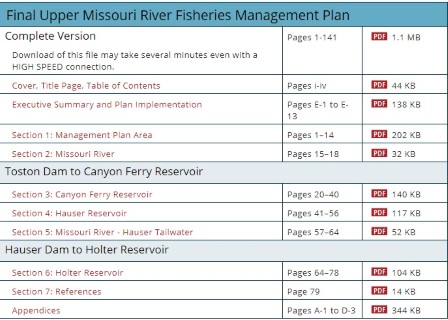
MORE INFORMATION -
It was discovered that on Wednesday October 15th, FWP is going to request approval from the Commission for them to send out drafts that would then be open for public comment. The problem is that the Upper Missouri River Chapter does not agree with some of the current regulation and changes on Canyon Ferry Lake and the Missouri River. They are requesting your assistance and that you send emails to the Commission asking for changes before going out for public comment. If enough people contact the Commissioner’s they might not approve the current draft and direct FWP to make revisions before it goes out for public comment.
#1; Eliminate the 3 inch experimental walleye gill nets.
Rational; These nets capture walleye that are 20 inch and larger. These fish are the anglers preferred size but are at a critical low abundance and therefore need to be conserved.
#2; Ask that the Upper Missouri River Lake Management Plan be adaptable on a yearly basis.
Rational; The current plan is only adaptable on a 3 year basis. That is not sufficient time to adapt to rapidly changing conditions.
#3; Eliminate the current “no possession limit” on walleye in the Missouri River below Holter dam.
Rational; The current regulation was approved by the Commission, it was a political decision, that was not recommended by FWP, and was not supported by FWP’s scientific data. FWP’s data confirmed that walleye were not negatively impacting the trout fishery.
#4; Make different fishing regulations on the Missouri River above Canyon Ferry Lake to Three Forks. The current regulations are the same as the lake, 20 walleye daily with only 1 over 20 inches and 40 in possession.
Rational; the river section is a different environment than the reservoir and therefore should not be jeopardized with the lake possession limits. The walleye regulations should be the same as the rest of Montana’s waters which is 5 walleye daily and 10 in possession.
#5; Mandatory catch and release perch in Canyon Ferry Reservoir from February 15th through November 15th.
Rational; Perch is the primary forage fish in the lake and are at extremely low levels and need protection. During the ice fishing season, perch are often retrieved from deep water and would not survive if released.
Lakes and Fishing Reports
 Lakes and Ramps Info
Lakes and Ramps Info
 Fishing
Links
Fishing
Links
 Aquatic
Nuisance
Aquatic
Nuisance
Fishing Report -
Fishing Report - February 2019
Anglers are reminded that ice conditions can be extremely variable. Ice thickness can range from thick enough to support a vehicle to open water. Extreme caution should be used when accessing the ice.
Canyon Ferry: Rainbow trout continue to be caught near shore on the south end of the reservoir using ice jigs and flies tipped with worms or maggots. Yellow perch, and a few walleye, are being caught in 35 feet of water out from Hole-in-the-Wall using Hali jigs or Swedish Pimples tipped with maggots. Ice conditions have been reported at 14 to 16 inches from south end of the reservoir to Confederate Bay and 10 inches near the dam. Adam Strainer, FWP, Helena
Hauser: Fishing continues to be slow for all species. A few rainbows are being caught in the Causeway on jigs and maggots or worms and fished 6 feet below the ice. Rainbows are being caught from shore below Canyon Ferry Dam on worms. A few perch and an occasional walleye are being caught at the Causeway under the powerlines. The ice in the Causeway is 6 to 12 inches and Black Sandy has 12 inches of ice. Troy Humphrey, FWP, HelenaHolter: The perch bite is inconsistent with some anglers doing well around the Prairie Dog Town or Indian Trail areas in 40 to 50 feet of water. An occasional rainbow is being caught as well. Holter has 10 inches of ice with a combination of slush and snow on top. Troy Humphrey, FWP, Helena
Helena Valley Regulating Reservoir: Kokanee action is slow with a few being caught while using jigs and maggots or corn at 20 feet below the ice in 25 to 35 feet of water. Small perch are being caught consistently just off the bottom in 15 to 25 feet of water throughout the reservoir. There is 14 inches of ice. Troy Humphrey, FWP, Helena
Spawning
2017 Canyon Ferry and Fort Peck Spawning Report
2016 Canyon Ferry and Fort Peck Spawning Report
2015 Canyon Ferry and Fort Peck Spawning Report
2014 Canyon Ferry and Fort Peck Spawning Report
2013 Canyon Ferry and Fort Peck Spawning Report
2012 Canyon Ferry and Fort Peck Spawning Report
2011 Canyon Ferry and Fort Peck Spawning Report
Fort Peck and Canyon Ferry Spawning Report 2018
FORT PECK
April 24, 2018
After what seemed to be a winter that would never end, things have finally decided to break loose on Fort Peck Reservoir. We managed to get holding pens, barges, and trap nets set over the weekend even though there was still ice cover on most of the main lake. Today was our second day of the season checking trap nets and collecting walleye. Water surface temperatures varied greatly from one location to another in the upper Big Dry Arm where our trap nets have been placed. In some of the shallower locations, we’ve observed water surface temperatures close to 55 degrees, but water surface temperatures towards the main lake are still in the low 40’s. As a result we’ve been seeing a combination of green (holding eggs), ripe (releasing eggs), and spent(released their eggs) female walleye.
We’ve managed to hold two egg-takes since we’ve started due to a decent number of ripe female walleye collected. We collected approximately 3.2 million eggs on Monday and 2.7 million eggs on Tuesday giving us 5.9 million walleye eggs thus far. We also collected 1.1 million pike eggs that will be used to meet stocking requests for certain waterbodies in eastern Montana for 2018.
Photo: Ripe female walleye waiting to be spawned
Photo: Ryan Lott collecting eggs from a ripe female walleye
Photo: Hank Poeschl, Mark Sigler, and Ed Dodge with a female walleye collected from a trap net
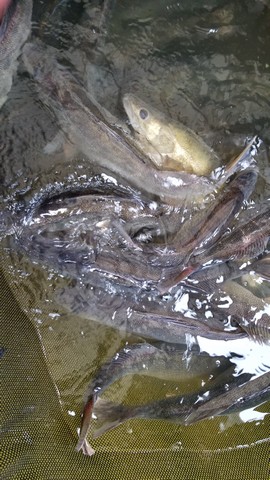
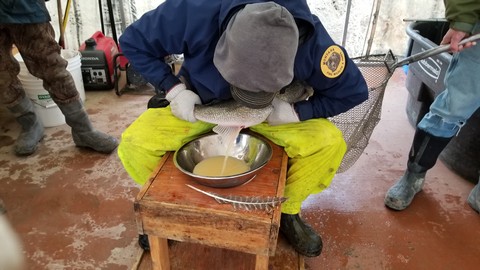
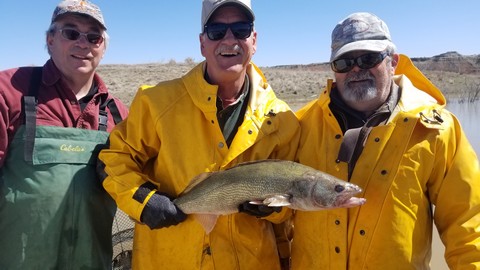
April 28, 2018
The weather has cooperated for the most part over the last few days in the Big Dry Arm of Fort Peck Reservoir. Water surface temperatures today in our trap netting locations ranged from 55 degrees in the far upper portions to 44 degrees further down the reservoir. As a result, we continue to see a mixed bag in the condition of female walleye being collected with a combination of greens, ripe, and spent fish.
Given the much later start and variable water temperatures throughout the reservoir, it’s not surprising we’re seeing spent female walleye along with ripes and greens in our trap net catches. The good news is we’ve still managed to capture enough ripe and have a few more green females ripen up so we can collect a few more eggs. Since the last update, we’ve managed to hold two more small egg-takes which will bring our total close to 12 million eggs. It looks like there might be a cold front moving our way, but we’ll continue to plug along and see what we can do.
Photo: Sorting through a trap net full of fish
Photo: Sean Lott with a big green female walleye being transferred to a holding pen
Photo: Ron, Jacob, and AJ Hunziker with a female walleye
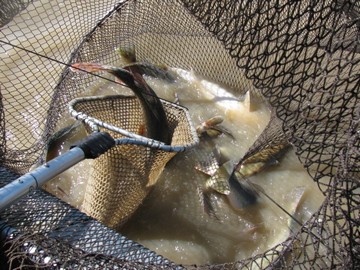
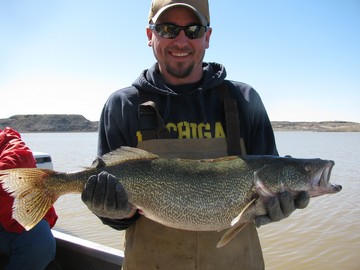
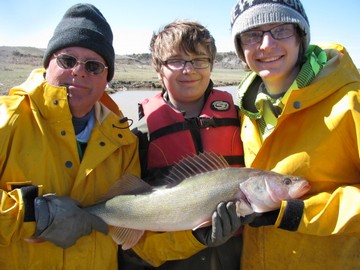
April 30th 2018
The weather has cooled a bit from the warm temperatures we experienced over the weekend in the Big Dry Arm of Fort Peck Reservoir. It’s hard to believe air temperatures yesterday were in the 70’s, and today we only had a daytime high in the upper 40’s and bundled up! Water surface temperatures are ranging from 47 degrees to 56 degrees throughout our trap netting locations. We’re continuing to collect good numbers of walleye, but the condition of females captured hasn’t been conducive to collecting large amounts of eggs.
Trap net catches continue to be comprised of either ripe or spent female walleye with very few greens. The lack of green females, which typically ripen up in the holding pens and contribute to our effort, have given us fewer fish to spawn this season. However, we did manage to hold another small egg-take since the last update due to the ripe females captured the past couple days. We managed to collect approximately 3.5 million eggs on Sunday which should put us a little over 15 million eggs thus far. It looks like the weather will start to warm up over the next few days so we’ll plug along and see what we can do.
Photo: Jack Boonstra wrangling some wily walleye
Photo: Jack Boonstra with a huge smallmouth buffalo
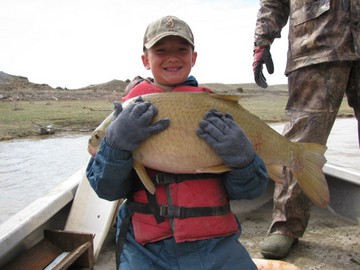
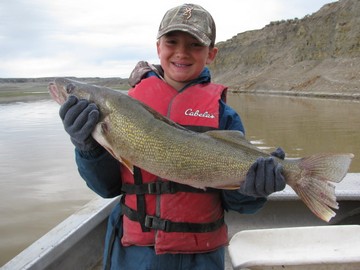
May 4, 2018
The weather has really warmed in the Big Dry Arm of Fort Peck Reservoir. Water surface temperatures throughout our trap netting locations have been ranging from 50 to 58 degrees. However, we haven’t seen much of an increase in walleye spawning activity and it’s likely things may be winding down based on what we’ve been finding in our trap nets.
A majority of the female walleye captured in trap nets continue to be spent with very few greens. We’ve continued to capture ripe female walleye, but their numbers appear to be decreasing as well. Despite the decrease in numbers, the numbers of ripe females captured have given us a few more fish to spawn.
The steady trickle of ripe females captured has allowed us to hold three small egg-takes since the last update. Each egg-take we’ve managed to collect roughly 1.5 to 2 million more eggs. This should bring our total to approximately 20 million eggs. We plan on continuing through the weekend in hopes to collect a few more eggs to add to the total.
Photo: Richard Lockman with a healthy green female walleye
Photo: Sorting through a trap net full of fish
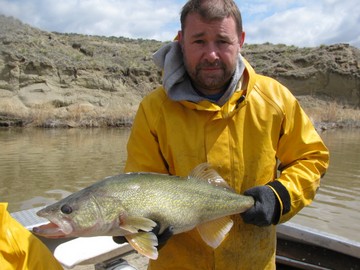
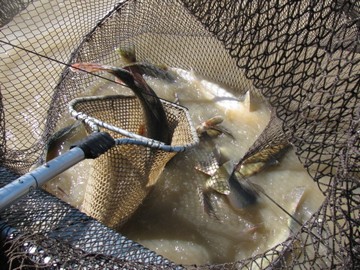
May 15, 2018
Well, it’s been an interesting walleye spawning season this year on Fort Peck Reservoir. It seems like the weather went from winter straight into summer. Water surface temperatures in the upper Big Dry Arm have been ranging from 56 to 66 degrees throughout our trap netting locations. These warmer temperatures have led to a dwindling number of walleye, but other species have taken their place as temperatures are becoming favorable for their spawning. Based on this, we’ve decided to pulled our nets for the 2018 season.
Not only have there been fewer numbers of walleyes collected in the trap nets, but a majority of females collected continue to be spent. Fortunately, we have managed to collect a handful of ripe female walleye to hold two more small egg takes since the last update. These two small egg collections have given us close to 2 million more eggs to add to our total. This should give us close to 22 million total eggs for the season which was half our goal of 50 million eggs. So what does this mean?
It looks like there should be enough eggs, which will turn into fry, to stock the rearing ponds for fingerling production; however, there will likely be very few walleye fry plants. Fort Peck Reservoir receives a majority of the walleye fry stockings so it will be impacted the most. Even though fewer eggs were collected this year, it is possible that the high number of spent females captured this year spawned on their own which could compensate for the loss of fry plants. Increasing water levels have created more spawning and rearing habitat which should also lead to improved forage conditions. These factors can greatly aid in the survival of any naturally reproduced or stocked walleyes.
On behalf of the fisheries and hatchery staff, I would like to thank all the volunteers who assisted in this year’s walleye spawning operation. We all look forward to seeing you again next year and best of luck fishing.
Photo: Fish culturist Bob Braund with a large female walleye
Photo: Sean Uy with a BIG bigmouth buffalo
Photo: James Poitra with a channel catfish enjoying the warm water
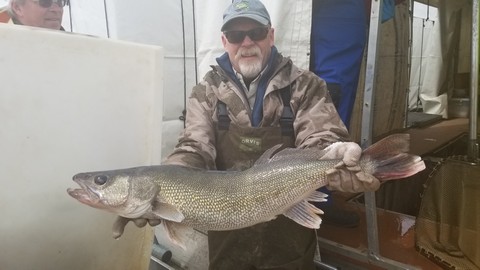
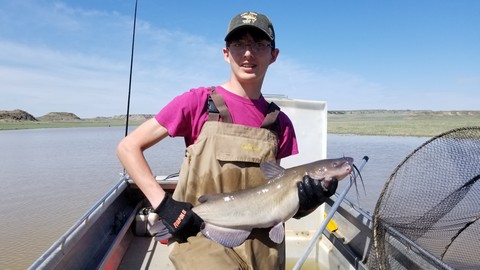
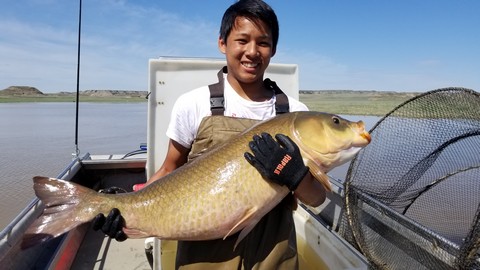
Monthly Fishing Tips
Covering the Basin for Icing Walleyes
Anticipation would be a great word to describe what every ice fisherman is feeling this time of year! Chances are the walleyes still have their fall feed bag on, which means they will be fairly aggressive. This can make for a really fun bite at first and last light, all the way up to at least an hour after dark. In tannic water it can make for a great bite all day long!
Of course, in order to hook into one of these fish, you first have to find them. So, when it comes to location, we like to look for basin areas that are from 15 to 30-feet deep. The best place to target walleyes is close to drop-offs and within a few hundred feet of the base of them. As winter rolls on, they will become harder to catch since they will begin to roam the basin, making it a little more difficult to pinpoint where they are. However, during early ice they will still be found closer to the drop offs.
It is important to note that this isn’t the only early season pattern, as shallow weeds and weed edges can produce in some lakes, but the shallow basin areas can usually hold good populations of fish. The best spots to locate them is off points, inside cups and areas between drop-offs that are close together, such as in between two sunken islands that are close together.
Now that you know where to find the fish, it is time to catch them. This means it is Hot Box time. When we say Hot Box, we are referring to the JT Outdoors Hot Box, which is a heated aluminum box keeps holes open up to 20 degrees below zero!
We like to use it with a dead stick (snare rod), although at this time of year some prefer the more conventional tip up flag option. The 36” Snare Rod, also from JT Outdoors, has an integral Nitinol (an alloy blend of nickel and titanium) spring bobber that is virtually indestructible and kink resistant. It also contains a highly visible indicator bead at the end to let you know when you have a strike. The rod itself is a high-grade fiberglass with a super slow action. This provides a parabolic action, which allows the rod to load ultra-subtly.
Once the fish grabs the bait, the spring bobber and rod loads the fish. When the fish begin to feel this tension, they react by trying to swim away, which in turn puts further load on the rod and the fish end up setting the hook themselves.
The length and long bend of the rod give plenty of time for anglers to get to the hole and land the fish. Not only can no other method or set-up match the sensitivity of this system, but it gives anglers the ability to spread out lines as they would tip-ups, yet be able to fight the fish with a rod instead of pulling it up hand over hand.
While you can also jig, it is important to remain mobile. It is imperative to spread lines from the base of the drop-off and into the basin to get bites. We like to give our Hot Boxes about 45 minutes in one location before moving. We move more while jigging, as we rely on our Lowrance Ti2 to mark fish to be sure we’re on them.
When it comes to bait; suckers, shiners or larger fatheads work well with the Hot Boxes. Set the depth of the bait anywhere from 6-inches to 3-feet off bottom, depending on the water clarity. If
the fish will come up for the bait, you’ll get more aggressive bites and catch more fish, so always experiment with your set-ups until the fish tell you what they want. Jig set-ups can be spoons, Moonshine Shiver Minnows and plain jigs with minnows. We use many of the Clam, Moonshine and Sidewinder spoons, and most of the time we have a minnow head on the spoon too.
While it may be hard to avoid the itch to get out on the ice, we can’t stress enough the importance of waiting until the ice is safe enough to do so! Always take along and wear a float suit such as the IceArmor by Clam Rise and Ascent suits. It is also important to wear ice picks this time of year so if you do break through you have the means to crawl out.
Be sure you are constantly using a spud to check the depth of the ice as you make your way out. If it becomes unsafe turn around and come back another day. If there is enough ice to take a four-wheeler or sled out, be sure to pack a Nebulus Emergency Floatation Device. This product could save your life if you break through the ice on your machine.
While early ice is very productive and a great way to get your Next Bite, it can also be treacherous. So, have fun, but always remember to be careful!


